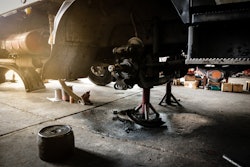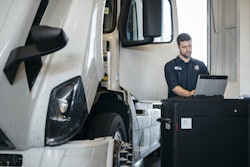
[This article was originally published in 2007 by Trucks, Parts, Service. It has been updated to include more timely information.]
What is brake balance? A vehicle’s brakes are said to be in balance if all brakes apply and release at about the same time, with each brake developing the appropriate braking force for its weight load.
On the other hand, brake imbalance, such as when a tractor brakes faster and more aggressively than its trailer, causes rapid lining wear on the hardest-working brakes, bumping of tractors by trailers, jackknifing and panic stops with more panic than stop.
Where’s The Imbalance?
Torque imbalance, pressure imbalance and different tire sizes can contribute to what typically is called brake force imbalance.
Stopping distances on a vehicle equipped with drum brakes will increase when all brakes on a heavily laden combination vehicle are cool but maladjusted. And, when these maladjusted brakes become hot, causing drums to expand, linings to fade and brake-chamber stroke to increase, a 75 percent or more increase in stopping distance easily can be expected.
Automatic slack adjusters don’t always solve this problem, because worn parts and lack of maintenance may cause them to stop working properly.
To muddy the water even more, brakes with properly-functioning automatic slacks are constantly working, promoting faster friction material wear than with manual slacks, which only are adjusted periodically. Therefore, a mix of automatic and manual slacks can unbalance the braking performance of a tractor-trailer combination that originally had no problem with over-braking or premature friction material wear.
RELATED: Looming mandate will impact composition of brake friction material
Torque imbalance, or lack of uniform friction-material to friction-surface contact, means that some of the brakes can have more or less stopping power, because of maladies such as oil or grease on the friction material; polished drums or rotors; glazed friction material; linings or pads with mixed friction capabilities at one or more wheels; out-of-spec drums or rotors; incorrect adjustment; different size brake chambers; improperly installed automatic slacks; inoperative or maladjusted antilock (ABS) wheel speed sensors; or improperly speced axle GVWR.
Pneumatic or air pressure imbalance occurs when the tractor-trailer’s system delivers improper air pressures to brake chambers on a combination vehicle.
The most common causes are incorrect or malfunctioning relay valves. Quick-release valves also can have characteristics that upset pressure balance. Other causes include air leaks, air system contamination, a front-axle-limiting valve and excessive use of the trolley valve.
Timing imbalance occurs when some brakes receive air faster than others. Common causes include: oversized control lines on pre-1991 trailers, which slow brake application; poor plumbing design or improper installation; and failure to use booster valves, where appropriate.
“Maintaining good service system response, without adversely impacting the pneumatic balance across all the axles of a combination vehicle, is important,” says Bendix Commercial Vehicle Systems. “Maintaining good pneumatic balance is crucial in improving brake response.” Bendix engineers say that ideal pneumatic balance is achieved when the air delivered to each axle doesn’t vary by more than 2 psi during a 10 psi to 40 psi application.
An exception to this rule would be the ill-advised mating of an S-cam-equipped tractor with a wedge-braked trailer. Because wedge brakes have smaller chambers and require more psi than S-cams to make linings contact the drum, the wedge-braked trailer would require higher air pressure than the tractor for balanced braking during low-pressure applications.
Low-pressure Imbalance
Brake system engineers say about 95 percent of braking involves application pressures below 25 psi. And approximately 84 percent of braking is done at application pressures of 15 psi or less.
When Federal Motor Vehicle Safety Standard 121 took effect in 1975, it required trailers to be compatible with a tractor simulator delivering a massive slug of air. To achieve compatibility, trailers needed 1/2-in. OD (3/8 in. ID) control lines instead of the 3/8-in. OD (1/4-in. ID) lines previously used.
During normal braking, a real-world tractor doesn’t deliver enough air to fill the trailer’s oversized control line. Consequently, trailer braking is delayed, especially with multiple-trailer combinations.
RELATED: Hydraulic leaks, tensioner cable issues, fasteners lead to NHTSA recalls
In some cases, the delay treats drivers to a disconcerting bump as the trailer pushes the power unit. If bump comes to shove when braking through a slippery curve, for example, a jackknife is possible.
Seeking to eliminate the delay, the National Highway Traffic Safety Administration (NHTSA) modified the tractor simulator and changed maximum application/release times for trailers built on/after May 3, 1991; and also specified air-delivery times for control-line gladhands at the rear of tractors, trailers and dollies built on/after May 3, 1991.
Trailer bumping can be eliminated by retrofitting a smaller control line to the trailer and by making changes to the tractor that would speed gladhand timing. This would cause trailer brakes to apply faster during normal brake applications. And there shouldn’t be any degradation of stopping distance during panic stops.
Alternatively, tractor brake application can be slowed by a plumbing change. But slowing tractor brakes has the potential to adversely affect stopping distance, NHTSA warns. So, making a change in the power unit’s brake system is an ill-advised, but conceivable move.
RELATED: Do’s and don’ts of combining air disc, drum brakes
For example, trailer brake release time can be cut drastically by adding a quick-release valve at the tractor protection valve. It must be strongly emphasized, however, that any brake modification should have engineering approval by the vehicle OEM as any deviation from OEM plumbing has the potential to cause more problems than it cures.
High-pressure Imbalance
If a tractor’s brakes do most of the work, a combination vehicle can’t slow down very quickly without the driver pushing harder on the brake pedal.
Should the tractor continue to brake more aggressively than the trailer, the risk of locking the drive axle (on non-ABS-equipped units) and jackknifing is substantial, especially on a slippery road with an empty or lightly-laden trailer in tow. While ABS prevents over-braked wheels from locking, it’s not a substitute for balanced braking.
Sustained high-pressure braking of an ABS-equipped tractor is discouraged because a non-ABS-equipped trailer (or one with non-functional ABS) may receive enough air to lock its brakes, perhaps causing it to swing rapidly out of its traffic lane.
Further, a tractor with non-functional ABS would be inclined to jackknife as a consequence of full and sustained braking. For those reasons, NHTSA admonishes drivers not to change their normal braking habits when piloting ABS-equipped combination vehicles.
The addition of air disc brakes to the equation complicates things even more. Because of the increased capability of air disc brakes to control braking on the tractor, the drum brakes on a trailer tend to develop heat fade faster, transferring most of the work to the discs. This has prompted some manufacturers to suggest that there is an inherent value to specifying air disc brakes on trailers, avoiding many of the problems associated with mixing and matching.

Cracking The Pressure Problem
By design, some tractors display a lightning-fast draw when shooting air to their own brakes before passing it along to the trailer. Further, some trailers resist accepting air from a tractor because they have a relay valve with a relatively high crack pressure. Depending on the setup, tractor brakes can be applied without the trailer relay valve ever approaching its crack pressure.
Crack pressure, expressed in psi, is the air required to force a valve open. All valves presumed to have identical crack pressures are not necessarily created equal. Even a new, high-quality valve rated at 4 psi crack pressure may open at anywhere from 3.5 psi to 4.5 psi. In contrast, a new and high-quality valve rated at 7.5 psi crack pressure may require anywhere from 4.5 psi to 10.5 psi before opening.
A valve’s crack pressure largely is determined by the stiffness of its piston-return spring. If a valve is replaced with a remanufactured unit, or with other than an original-equipment valve, crack pressures can vary because of differences among springs.
The moral of this story is that pneumatic balance is most easily achieved by using low-crack-pressure valves, maintained with OE replacement valves. It doesn’t take much of a disparity in crack pressures to cause a problem.
Good Intentions, Bad Balance
Some tractors are over-braked because tractor axles have been over-spec'd for the loads typically carried, and brakes are sized according to the gross axle weight rating. Benefits of greater-than-needed weight capacity include higher resale value, plus the fact that axle durability is enhanced by larger gearsets and bearings. But the tractor always will over-brake if axle loading is substantially less than rated capacity. This caveat applies equally to trailers with over-spec'd axles.
RELATED: Carriers at TMC meeting share frustrations with their dealer partners
The solution to overspec'd brakes may be to switch to less-aggressive linings or (if possible) to attach chamber push rods to a different slack adjuster hole to reduce braking force. Keep in mind though, that spacing between slack adjuster holes varies by make. So it’s wise to ask the vehicle OEM or brake component supplier for technical advice before making changes.
An onsite, brake-torque-balance test is also advised before modifications are made. A suitable procedure is offered by Recommended Practice (RP) 613 Brake System Torque Balance Test Procedure, available from the Technology & Maintenance Council (TMC) .
Electronics Can Help
Although relay valves ultimately govern when the air is delivered to the foundation brakes, there is a way to speed the signal to the relay valves by using an electronic braking system, or EBS. This system sends an electronic signal to the relay valves, telling them to open immediately. Brake response is enhanced, and air pressure is sent on its way to the foundation brakes more quickly.
“EBS can have a positive influence in the reduction of possible tractor/trailer brake pressure imbalance,” says WABCO. “The technology is capable of estimating the deceleration contribution of each axle of the tractor/trailer combination, and crack pressures can be electronically adjusted to ensure brakes apply in a balanced fashion.”
The company adds, “While the optimum solution is to equip both tractor and trailer with EBS, pressure balance will improve if just the tractor is fitted with EBS.”
Torque Imbalance
The fact that a combination vehicle provides equal air pressure to all brakes at the same time isn’t the only concern with respect to balanced braking.
As mentioned earlier, torque imbalance results from some brakes having better adjustment, bigger chambers, longer slacks and more aggressive friction material than others. Most of these disparities are immediately evident.
Differences between linings are most likely to sneak up and present you with a nasty surprise. That’s because lining friction, fade and recovery characteristics at various temperatures can vary widely.
In the early days of non-asbestos linings, certain formulations were prone to swell excessively with heat. Because of this, the swelled linings often caused tightly-adjusted brakes to drag after the treadle was released.
After the lining cooled down, the linings might not shrink to previous dimensions. In some instances, significant and permanent lining growth required slacks to be backed-off before the brakes could be released. While that type of scenario has virtually disappeared, other problems are painfully persistent. Consider edge codes, as a prime example.

Designed to indicate a lining’s aggressiveness, edge-code markings often wear off. That’s no great loss, however, because even within the same edge code, friction can vary by as much as 40 percent.
To maintain some degree of consistency, spec the same brand and type of lining on tractors and trailers and use the same material for relining.
Torque Degradation
Even if tractors and trailers initially are well matched, torque balance can degrade over time. For example:
- Friction material may be contaminated by leaky, improperly installed wheel oil seals or ill-advised and generous greasing of the cam assembly on drum brakes. A leaky oil seal on new equipment could be due to assembly line errors. In turn, a leaky seal on older equipment may indicate a need for better oil seals or technician retraining.
- Drums can become deeply scored or bell-mouthed, and disc brake rotors can become dished, preventing even contact with the friction material at one or more wheels. Even new replacement drums can be bell-mouthed or eccentric, requiring that they be trued in a lathe. In some cases, radius grinding of linings may be required for a good fit. While mild heat checking is acceptable, any drum or rotor with deep cracks should be scrapped.
- Brake shoe return springs can stretch or even break. Even if they look OK, replace the springs at every reline or braking can become a drag. The same admonition applies to rollers that have become flat spotted.
- S-cams can become so worn that brake torque is thrown out of whack. Worn camshafts and their splines and bushings also degrade performance. Pay special attention to the condition of the bushing, because it’s responsible for centering the cam and shoe assembly in the drum. Ideally, the bushings should be replaced at every reline.
- Bent spiders degrade lining-to-drum contact. A heat-and-hammer approach to removing anchor pins may warp the spider.
- Sliding disc brake calipers can become seized, causing accelerated wear of the inner disc brake pad. Make sure caliper pins and sliding surfaces are properly lubricated to assure proper function of the disc caliper.
- Valves can slow down or fail to operate because of gum and carbon build-up from air contaminated with water and oil vapor – especially if tanks aren’t drained routinely and an air dryer isn’t used.
- Retrofitting brake chambers or slack adjusters of the wrong size is dangerous. Problems can also result from mixing two brands of automatic slacks on the same unit, due to differences in performance, even if they’re the same size. Automatic slack adjusters can malfunction or wear out, especially if nobody bothers to lubricate them. First, measure for excessive push rod stroke as brakes are applied. Inspect the assembly for excessively worn holes in the yolk and slack adjuster, worn clevis pins and general looseness. Slacks must be mounted at the proper angle, as determined by use of installation templates that vary by application and brand of slack. In practice, however, the mounting angle may be compromised by clearance problems experienced by the OEM. For that reason, clearance should be checked before making a change in mounting position.
- Retrofit of remanufactured or aftermarket air valves can affect pneumatic balance. For one thing, the crack pressure of relay or quick-release valves fitted with aftermarket springs can vary considerably. Just because a valve looks right hardly indicates it’s a suitable replacement for original equipment. Even where valves of the same make and model are used as replacements, crack pressures and pressure differentials may vary because of differences in bore size and manufacturing tolerances.
- Retrofit of low-profile tires having a radius 18 percent smaller than original-equipment tires can cause a vehicle to be over-braked. In fact, an 18 percent reduction in rolling radius can result in an 18 percent increase in braking force. The change may, for example, result in the lockup of lightly-laden, non-ABS-equipped trailers in the course of normal braking. Further, smaller tires rotate faster at a given road speed. Consequently, linings will engage the drums at higher rpm and run hotter especially when braking on downgrades. Going to the next smallest chamber will reduce torque about 20 percent. And changing to a less aggressive lining – or, with engineering approval, placing some sort of pressure modifier in the system – often will do the trick.
- Drums and rotors can be damaged by consistent overheating, localized wear from lack of uniform friction material contact or exposure to abrasive material. Surfaces with a mirror-like finish should be roughed up with 80-grit emery cloth and, if accompanied by a glazing on the shoes or pads, should trigger a quest for a more suitable friction material.
- If it appears that foreign abrasive material is causing excessive wear along the edges of the trailer lining contact area, or in areas coinciding with lining rivet holes, remove the lower dust shield (if equipped) to provide an exit. When checking a drum for excessive wear, its inner diameter shouldn’t be more than .12 in. more than the original spec.
- When resurfacing drums, the finished inner diameter shouldn’t be over .08 in. beyond original spec. And runout shouldn’t exceed .01 in. The same goes for disc brake rotors. When checking rotor thickness, they shouldn’t be more than .12 in. less than the original spec, and don’t resurface more than .08 in. less than the original spec. Lateral runout shouldn’t exceed .01 in., and radial runout shouldn’t exceed .035 in.
Achieving brake balance is not difficult, as long as you’re aware of what to look for that may cause the imbalance to occur. Once the cause is known, inform your customer and let them know what needs to be done to help prevent jackknifing and ensure a safe ride.











